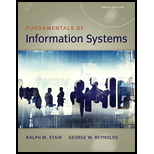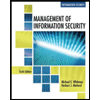
Fundamentals of Information Systems
9th Edition
ISBN: 9781337097536
Author: Ralph Stair, George Reynolds
Publisher: Cengage Learning
expand_more
expand_more
format_list_bulleted
Question
Chapter 8, Problem 3RQ
Program Plan Intro
The reason that many organizations have a formal process for requesting a system investigation.
Expert Solution & Answer
Want to see the full answer?
Check out a sample textbook solution
Students have asked these similar questions
this project is NOT for graded(marks) purposes, please help me with the introduction. give me answers for the project. i will include an image explaining everything about the project.
Java Graphics
(Bonus
In this lab, we'll be practicing what we learned about GUIs, and Mouse events. You will need to
implement the following:
A GUI with a drawing panel. We can click in this panel, and you will capture those clicks as a
Point (see java.awt.Point) in a PointCollection class (you need to build this).
The points need to be represented by circles.
Below the drawing panel, you will need 5 buttons:
O
о
о
○
An input button to register your mouse to the drawing panel.
A show button to paint the points in your collection on the drawing panel.
A button to shift all the points to the left by 50 pixels.
The x position of the points is not allowed to go below zero.
Another button to shift all the points to the right 50 pixels.
"
The x position of the points cannot go further than the
You can implement this GUI in any way you choose. I suggest using the BorderLayout for a panel
containing the buttons, and a GridLayout to hold the drawing panel and button panels.
Regardless of how…
also provide the number of moves(actions) made at state A and moves(actions) made state B. INCLUDE Java program required(this question is not graded)
Chapter 8 Solutions
Fundamentals of Information Systems
Ch. 8 - Identify the pros and cons associated with both...Ch. 8 - Prob. 2LOCh. 8 - Identify and state the goal of each of the six...Ch. 8 - Prob. 4LOCh. 8 - Prob. 5LOCh. 8 - Prob. 6LOCh. 8 - Prob. 7LOCh. 8 - Prob. 8LOCh. 8 - Prob. 9LOCh. 8 - Prob. 10LO
Ch. 8 - Prob. 11LOCh. 8 - Prob. 12LOCh. 8 - Identify the key factors to be considered in...Ch. 8 - Prob. 1.1RQCh. 8 - Prob. 1.2RQCh. 8 - How would you go about selecting and recruiting...Ch. 8 - What do you think might be the biggest harriers to...Ch. 8 - Prob. 2.1RQCh. 8 - Following your discussion, one of the team members...Ch. 8 - There is likely to be some confusion over the role...Ch. 8 - What other potential problems can you anticipate...Ch. 8 - Prob. 3.1RQCh. 8 - Prob. 3.2RQCh. 8 - Prob. 3.1CTQCh. 8 - A safety-critical system is one whose failure or...Ch. 8 - Prob. 1SATCh. 8 - Prob. 2SATCh. 8 - Prob. 3SATCh. 8 - Prob. 4SATCh. 8 - The purpose of the system investigation phase is...Ch. 8 - Prob. 6SATCh. 8 - The overall emphasis of the ___________ phase is...Ch. 8 - The primary tool for assessing the software...Ch. 8 - Prob. 9SATCh. 8 - Prob. 10SATCh. 8 - Prob. 11SATCh. 8 - Prob. 12SATCh. 8 - A preliminary evaluation of software packages and...Ch. 8 - Prob. 1RQCh. 8 - Prob. 2RQCh. 8 - Prob. 3RQCh. 8 - Prob. 4RQCh. 8 - Prob. 5RQCh. 8 - What are the key elements of a system...Ch. 8 - Prob. 7RQCh. 8 - Prob. 8RQCh. 8 - Prob. 9RQCh. 8 - Prob. 10RQCh. 8 - Prob. 11RQCh. 8 - Prob. 12RQCh. 8 - Prob. 13RQCh. 8 - Prob. 14RQCh. 8 - An organization has selected and is now...Ch. 8 - Prob. 1DQCh. 8 - Thoroughly discuss the pros and cons of buying...Ch. 8 - Prob. 3DQCh. 8 - Prob. 4DQCh. 8 - Prob. 5DQCh. 8 - You have been assigned to write a newspaper report...Ch. 8 - Prob. 7DQCh. 8 - Define the Pareto principle, and discuss how it...Ch. 8 - Prob. 9DQCh. 8 - Prob. 10DQCh. 8 - Prob. 11DQCh. 8 - Prob. 12DQCh. 8 - Identify and briefly discuss four key tasks...Ch. 8 - Prob. 1PSECh. 8 - Prob. 2PSECh. 8 - A new sales ordering system needs a relational...Ch. 8 - Prob. 1WECh. 8 - Prob. 2WECh. 8 - Do research to determine the current level of...Ch. 8 - Prob. 1CECh. 8 - Perform research to learn what is required to have...Ch. 8 - Identify an information system frequently employed...Ch. 8 - It is perhaps not surprising that Etsy was an...Ch. 8 - Prob. 1.2CSCh. 8 - What would be some of the criteria you would use...Ch. 8 - Prob. 2.1CSCh. 8 - Prob. 2.2CSCh. 8 - Prob. 2.3CS
Knowledge Booster
Similar questions
- You are given a class that processes purchases for an online store. The class receives calls to: • Retrieve the prices for items from a database • Record the sold items • Update the database • Refresh the webpage a. What architectural pattern is suitable for this scenario? Illustrate your answer by drawing a model for the solution, showing the method calls/events. b. Comment on how applying this pattern will impact the modifiability of the system. c. Draw a sequence diagram for the update operation.arrow_forward2. The memory management has contiguous memory allocation, dynamic partitions, and paging. Compare the internal fragmentation and external fragmentation for these three approaches. [2 marks] 3. Suppose we have Logical address space = 24 = 16 (m = 4), Page size=2² =4 (n = 2), Physical address space = 26 = 64 (r = 6). Answer the following questions: [4 marks] 1) Total # of pages ? 2) Total # of frames ? 3) Number of bits to represent logical address? 4) Number of bits to represent offset ? 5) Number of bits to represent physical address? 6) Number of bits to represent a page number? 7) Number of bits to represent a frame number / 4. What is translation look-aside buffers (TLBS)? Why we need them to implement the page table? [2 marks] 5. Why we need shared pages for multiple processes? Give one example to show the benefits. [2 marks] 6. How to implement the virtual memory by using page out and page in? Explain with an example. [2 marks] 7. We have a reference string of referenced page…arrow_forwardGood morning, please solve this trying to follow this criteria. (use Keil) Abstract describing the requirements and goals of the assignment. List file with no errors or warnings. Brief description of your implementation design and code. Debugging screen shots for different scenarios with your reference and comments. Conclusion (and please give me the code without errors, make sure it is working)arrow_forward
- Good mrng, please solve this trying to follow this criteria. (use Keil) Abstract describing the requirements and goals of the assignment. List file with no errors or warnings. Brief description of your implementation design and code. Debugging screen shots for different scenarios with your reference and comments. Conclusion (and please give me the code without errors, make sure it is working)arrow_forward#include <stdio.h> #include <stdlib.h> #include <unistd.h> int global_var = 42; // int* function(int *a) { int local_var = 10; // *a = *a + local_var; int *local_pointer = (int *)malloc (size of (int) * 64); // Allocated array with 64 integers return local_pinter; } int main() { int local_main[1024*1024*1024*1024*1024] = {0}; // initialize an array and set all items as 0 int *heap_var = (int *)malloc(size of(int) * 16); // Allocated array with 16 integers *heap_var = 100; function(heap_var); printf(“the value is %d\n”, *heap_var); free(heap_var); // release the memory return 0; } 1) draw the memory layout of the created process, which should include text, data, heap and stack [2 marks]. 2) Indicate which section the variables are allocated [2 marks]: global_var local_var, local_pointer local_main heap_var, *heap_var (the data that it points to) 3) Does this code have memory leaking (heap memory is not released)? [2 marks] 4) The…arrow_forward8. List three HDD scheduling algorithms. [2 marks] 9. True or False? The NVM has the same scheduling algorithms with HDD. Explain why? [2 marks] 10. Why the modern mouses use polling to detect movements instead of interrupts? [2 marks] 11. What is thrashing? How does it happen? [2 marks] 12. Given a reference string of page numbers 7, 0, 1, 2, 0, 3, 0, 4, 2, 3, 0, 3, 0, 3, 2, 1, 2, 0, 1, 7, 0, 1 and 4 frames show how the page replacement algorithms work, and how many page faults? [6 marks], 1) FIFO algorithm? [2 marks] 2) Optimal algorithm? [2 marks] 3) LRU algorithm? [2 marks] 13. List at least three file systems that you know. [2 marks] 14. In C programming, how the seek to a specific position in the file by offset? [2 marks]arrow_forward
- A Personal Address Book application program allows the user to add, delete, search, save, and load contact information. The program separates the user interface (command-line) and the internal processing subsystem. The internal processing system consists of the following classes: • • Contact Manager (responsible for add and delete operations) Contact Finder (responsible for the search operation) pataManager (responsible for save and load operations) a. What design pattern can be used to implement the user interface? Explain your answer using a class diagram for the entire system. b. Draw a UML sequence diagram to show the behavioral view of the Personal Address Book program, demonstrating what happens when a user enters new contact information.arrow_forwardA system comprises three components: A, B, and C. Calling A requires calling B, and calling B requires calling A. Component C is responsible for dissimilar tasks T#1, #2, and T#3. a. Comment on the modifiability of this system. What problems do you see in this system, and how would you solve them? b. Suppose that T#1 is performed by both component A and C. What does this indicate about A and C? How would you solve this problem?arrow_forwardPlease answer questions from number 1 to 3 if these questions in the image provided below(NOTE: THESE QUESTIONS ARE NOT GRADED!)arrow_forward
- In a client-server system for a hypothetical banking application, the clients are ATM machines, and the server is the bank server. Suppose the client has two operations: withdraw and deposit. Use the broker architectural pattern to document an initial architecture design for this system: a. Draw a class diagram for this system. Use a client-side proxy to encrypt the data using an encrypt operation and a server-side proxy to decrypt the data. b. Discuss how you plan to apply redundancy tactics on the server. Additionally, identify the quality attribute that this tactic will achieve and discuss any potential side effects of applying it.arrow_forwarda. Comment on how you would achieve higher performance for a hypothetical Trent Course Registration System, assuming it utilizes a client-server architecture. b. Suppose we want greater availability of the server. Discuss what kind of tactics should be used to achieve that.arrow_forwardImplement a C program to find the largest element in a given array. You must have a main function and a max function. The function int main() will declare an array with the values {12, 100, 10, 1000, 20, 5}. This array will be passed to the max function. The function int max() will perform the necessary operations to find the largest element of the array. After max () is finished, have main () print the largest value and its index in the array. Do not hard code your solution! If we test your code with different array values, we should still get the correct output. The following link may help you get started: https://www.tutorialspoint.com/cprogramming/c_function_call_by_reference.htmarrow_forward
arrow_back_ios
SEE MORE QUESTIONS
arrow_forward_ios
Recommended textbooks for you
 Principles of Information Systems (MindTap Course...Computer ScienceISBN:9781305971776Author:Ralph Stair, George ReynoldsPublisher:Cengage Learning
Principles of Information Systems (MindTap Course...Computer ScienceISBN:9781305971776Author:Ralph Stair, George ReynoldsPublisher:Cengage Learning Enhanced Discovering Computers 2017 (Shelly Cashm...Computer ScienceISBN:9781305657458Author:Misty E. Vermaat, Susan L. Sebok, Steven M. Freund, Mark Frydenberg, Jennifer T. CampbellPublisher:Cengage Learning
Enhanced Discovering Computers 2017 (Shelly Cashm...Computer ScienceISBN:9781305657458Author:Misty E. Vermaat, Susan L. Sebok, Steven M. Freund, Mark Frydenberg, Jennifer T. CampbellPublisher:Cengage Learning Information Technology Project ManagementComputer ScienceISBN:9781337101356Author:Kathy SchwalbePublisher:Cengage Learning
Information Technology Project ManagementComputer ScienceISBN:9781337101356Author:Kathy SchwalbePublisher:Cengage Learning Management Of Information SecurityComputer ScienceISBN:9781337405713Author:WHITMAN, Michael.Publisher:Cengage Learning,
Management Of Information SecurityComputer ScienceISBN:9781337405713Author:WHITMAN, Michael.Publisher:Cengage Learning, Fundamentals of Information SystemsComputer ScienceISBN:9781337097536Author:Ralph Stair, George ReynoldsPublisher:Cengage Learning
Fundamentals of Information SystemsComputer ScienceISBN:9781337097536Author:Ralph Stair, George ReynoldsPublisher:Cengage Learning Fundamentals of Information SystemsComputer ScienceISBN:9781305082168Author:Ralph Stair, George ReynoldsPublisher:Cengage Learning
Fundamentals of Information SystemsComputer ScienceISBN:9781305082168Author:Ralph Stair, George ReynoldsPublisher:Cengage Learning

Principles of Information Systems (MindTap Course...
Computer Science
ISBN:9781305971776
Author:Ralph Stair, George Reynolds
Publisher:Cengage Learning

Enhanced Discovering Computers 2017 (Shelly Cashm...
Computer Science
ISBN:9781305657458
Author:Misty E. Vermaat, Susan L. Sebok, Steven M. Freund, Mark Frydenberg, Jennifer T. Campbell
Publisher:Cengage Learning

Information Technology Project Management
Computer Science
ISBN:9781337101356
Author:Kathy Schwalbe
Publisher:Cengage Learning

Management Of Information Security
Computer Science
ISBN:9781337405713
Author:WHITMAN, Michael.
Publisher:Cengage Learning,

Fundamentals of Information Systems
Computer Science
ISBN:9781337097536
Author:Ralph Stair, George Reynolds
Publisher:Cengage Learning

Fundamentals of Information Systems
Computer Science
ISBN:9781305082168
Author:Ralph Stair, George Reynolds
Publisher:Cengage Learning